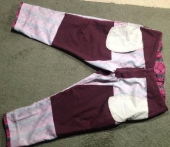
 2
2




 4
4




In 32 years of owning a chainsaw, this is the first time that I've drawn blood.

I won't get chainsaw pants. They are hot and reduce mobility. I must be able to move quickly.


 9
9




 9
9




 1
1






 4
4




Owner, Etta Place Cider
 4
4




Dale Hodgins wrote:I was tired and should have stopped an hour before it happened.
Moderator, Treatment Free Beekeepers group on Facebook.
https://www.facebook.com/groups/treatmentfreebeekeepers/





 2
2






 1
1




Works at a residential alternative high school in the Himalayas SECMOL.org . "Back home" is Cape Cod, E Coast USA.
 1
1




Rebecca Norman wrote:
They were cutting thornbushes, which are really awkward to get in and under, and of course one can get a thorn in the ear that makes you flinch.
Moderator, Treatment Free Beekeepers group on Facebook.
https://www.facebook.com/groups/treatmentfreebeekeepers/














Works at a residential alternative high school in the Himalayas SECMOL.org . "Back home" is Cape Cod, E Coast USA.




Moderator, Treatment Free Beekeepers group on Facebook.
https://www.facebook.com/groups/treatmentfreebeekeepers/





 2
2




Living in Anjou , France,
For the many not for the few
http://www.permies.com/t/80/31583/projects/Permie-Pennies-France#330873
 2
2




 1
1




 from 15ft +
from 15ft +
Living in Anjou , France,
For the many not for the few
http://www.permies.com/t/80/31583/projects/Permie-Pennies-France#330873




Moderator, Treatment Free Beekeepers group on Facebook.
https://www.facebook.com/groups/treatmentfreebeekeepers/





 1
1









"Instead of Pay It Forward I prefer Plant It Forward" ~Howard Story / "God has cared for these trees, saved them from drought, disease, avalanches, and a thousand tempests and floods. But he cannot save them from fools." ~John Muir
My Project Page




a whistle to call for help
Scott H.
Check out my house project!








 1
1




 1
1




Dale Hodgins wrote:I was kneeling in a hole cutting a stump below grade when the saw jumped and hit me just above-the-knee.
Today I will do what others won't, so tomorrow I can do what others can't.




















“In the absence of any other proof, the thumb alone would convince me of God's existence.”
Isaac Newton

|
Be the Mr. Rogers of your neighborhood. This tiny ad will help you:
permaculture bootcamp - gardening gardeners; grow the food you eat and build your own home
https://permies.com/wiki/bootcamp
|





